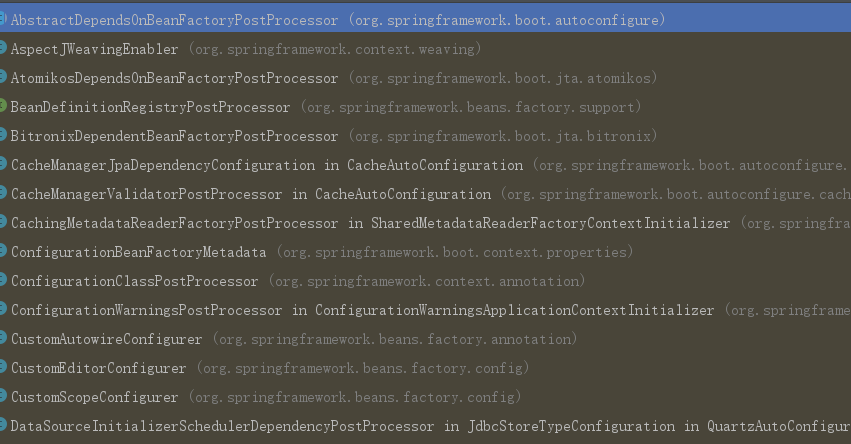Spring扩展点之BeanFactoryPostProcessor
前言
BeanFactoryPostProcessor接口是Spring中一个非常重要的接口,它的接口定义如下
public interface BeanFactoryPostProcessor {void postProcessBeanFactory(ConfigurableListableBeanFactory beanFactory) throws BeansException;}
当你实现了这个接口的时候,可以对还没有初始化的bean的属性进行修改或添加
BeanFactoryPostProcessor注册
与BeanPostProcessor的统一注册不同,BeanFactoryPostProcessor的注册是留给具体的业务实现的。它的维护是在AbstractApplicationContext类中
private final List<BeanFactoryPostProcessor> beanFactoryPostProcessors =new ArrayList<>();public void addBeanFactoryPostProcessor(BeanFactoryPostProcessor postProcessor) {Assert.notNull(postProcessor, "BeanFactoryPostProcessor must not be null");this.beanFactoryPostProcessors.add(postProcessor);}
执行原理
调用逻辑在AbstractApplicationContext.invokeBeanFactoryPostProcessors方法中
这个方法比较长,可以重点关注我添加注释的地方
protected void invokeBeanFactoryPostProcessors(ConfigurableListableBeanFactory beanFactory) {PostProcessorRegistrationDelegate.invokeBeanFactoryPostProcessors(beanFactory, getBeanFactoryPostProcessors());if (beanFactory.getTempClassLoader() == null && beanFactory.containsBean(LOAD_TIME_WEAVER_BEAN_NAME)) {beanFactory.addBeanPostProcessor(new LoadTimeWeaverAwareProcessor(beanFactory));beanFactory.setTempClassLoader(new ContextTypeMatchClassLoader(beanFactory.getBeanClassLoader()));}}public static void invokeBeanFactoryPostProcessors(ConfigurableListableBeanFactory beanFactory, List<BeanFactoryPostProcessor> beanFactoryPostProcessors) {Set<String> processedBeans = new HashSet<String>();// 1.判断beanFactory是否为BeanDefinitionRegistry,在这里普通的beanFactory是DefaultListableBeanFactory,而DefaultListableBeanFactory实现了BeanDefinitionRegistry接口,因此这边为trueif (beanFactory instanceof BeanDefinitionRegistry) {BeanDefinitionRegistry registry = (BeanDefinitionRegistry) beanFactory;List<BeanFactoryPostProcessor> regularPostProcessors = new LinkedList<BeanFactoryPostProcessor>();List<BeanDefinitionRegistryPostProcessor> registryProcessors = new LinkedList<BeanDefinitionRegistryPostProcessor>();// 2.处理入参beanFactoryPostProcessorsfor (BeanFactoryPostProcessor postProcessor : beanFactoryPostProcessors) {if (postProcessor instanceof BeanDefinitionRegistryPostProcessor) {BeanDefinitionRegistryPostProcessor registryProcessor =(BeanDefinitionRegistryPostProcessor) postProcessor;// 如果是BeanDefinitionRegistryPostProcessor则直接执行BeanDefinitionRegistryPostProcessor接口的postProcessBeanDefinitionRegistry方法registryProcessor.postProcessBeanDefinitionRegistry(registry);registryProcessors.add(registryProcessor);} else {regularPostProcessors.add(postProcessor);}}List<BeanDefinitionRegistryPostProcessor> currentRegistryProcessors = new ArrayList<BeanDefinitionRegistryPostProcessor>();// 3找出所有实现BeanDefinitionRegistryPostProcessor接口的Bean的beanNameString[] postProcessorNames =beanFactory.getBeanNamesForType(BeanDefinitionRegistryPostProcessor.class, true, false);for (String ppName : postProcessorNames) {// 校验是否实现了PriorityOrdered接口if (beanFactory.isTypeMatch(ppName, PriorityOrdered.class)) {// 获取对应的bean实例, 添加到currentRegistryProcessors中,currentRegistryProcessors.add(beanFactory.getBean(ppName, BeanDefinitionRegistryPostProcessor.class));processedBeans.add(ppName);}}// 排序(根据是否实现PriorityOrdered、Ordered接口和order值来排序)sortPostProcessors(currentRegistryProcessors, beanFactory);registryProcessors.addAll(currentRegistryProcessors);// 遍历currentRegistryProcessors, 执行postProcessBeanDefinitionRegistry方法invokeBeanDefinitionRegistryPostProcessors(currentRegistryProcessors, registry);// 清空currentRegistryProcessorscurrentRegistryProcessors.clear();// 4.与上边3的流程差不多,这是这里处理的是实现Ordered接口postProcessorNames = beanFactory.getBeanNamesForType(BeanDefinitionRegistryPostProcessor.class, true, false);for (String ppName : postProcessorNames) {if (!processedBeans.contains(ppName) && beanFactory.isTypeMatch(ppName, Ordered.class)) {currentRegistryProcessors.add(beanFactory.getBean(ppName, BeanDefinitionRegistryPostProcessor.class));processedBeans.add(ppName);}}sortPostProcessors(currentRegistryProcessors, beanFactory);registryProcessors.addAll(currentRegistryProcessors);invokeBeanDefinitionRegistryPostProcessors(currentRegistryProcessors, registry);currentRegistryProcessors.clear();// 5.调用所有剩下的BeanDefinitionRegistryPostProcessorsboolean reiterate = true;while (reiterate) {reiterate = false;// 找出所有实现BeanDefinitionRegistryPostProcessor接口的类postProcessorNames = beanFactory.getBeanNamesForType(BeanDefinitionRegistryPostProcessor.class, true, false);for (String ppName : postProcessorNames) {// 跳过已经执行过的if (!processedBeans.contains(ppName)) {currentRegistryProcessors.add(beanFactory.getBean(ppName, BeanDefinitionRegistryPostProcessor.class));processedBeans.add(ppName);reiterate = true;}}sortPostProcessors(currentRegistryProcessors, beanFactory);registryProcessors.addAll(currentRegistryProcessors);// 5遍历currentRegistryProcessors, 执行postProcessBeanDefinitionRegistry方法invokeBeanDefinitionRegistryPostProcessors(currentRegistryProcessors, registry);currentRegistryProcessors.clear();}// 6.调用所有BeanDefinitionRegistryPostProcessor的postProcessBeanFactory方法invokeBeanFactoryPostProcessors(registryProcessors, beanFactory);// 7.最后, 调用入参beanFactoryPostProcessors中的普通BeanFactoryPostProcessor的postProcessBeanFactory方法invokeBeanFactoryPostProcessors(regularPostProcessors, beanFactory);} else {invokeBeanFactoryPostProcessors(beanFactoryPostProcessors, beanFactory);}// 到这里 , 入参beanFactoryPostProcessors和容器中的所有BeanDefinitionRegistryPostProcessor已经全部处理完毕,// 下面开始处理容器中的所有BeanFactoryPostProcessor// Do not initialize FactoryBeans here: We need to leave all regular beans// uninitialized to let the bean factory post-processors apply to them!// 8.找出所有实现BeanFactoryPostProcessor接口的类String[] postProcessorNames =beanFactory.getBeanNamesForType(BeanFactoryPostProcessor.class, true, false);// Separate between BeanFactoryPostProcessors that implement PriorityOrdered,// Ordered, and the rest.// 用于存放实现了PriorityOrdered接口的BeanFactoryPostProcessorList<BeanFactoryPostProcessor> priorityOrderedPostProcessors = new ArrayList<BeanFactoryPostProcessor>();// 用于存放实现了Ordered接口的BeanFactoryPostProcessor的beanNameList<String> orderedPostProcessorNames = new ArrayList<String>();// 用于存放普通BeanFactoryPostProcessor的beanNameList<String> nonOrderedPostProcessorNames = new ArrayList<String>();// 8.1 遍历postProcessorNames, 将BeanFactoryPostProcessor按实现PriorityOrdered、实现Ordered接口、普通三种区分开for (String ppName : postProcessorNames) {// 8.2 跳过已经执行过的if (processedBeans.contains(ppName)) {// skip - already processed in first phase above} else if (beanFactory.isTypeMatch(ppName, PriorityOrdered.class)) {// 8.3 添加实现了PriorityOrdered接口的BeanFactoryPostProcessorpriorityOrderedPostProcessors.add(beanFactory.getBean(ppName, BeanFactoryPostProcessor.class));} else if (beanFactory.isTypeMatch(ppName, Ordered.class)) {// 8.4 添加实现了Ordered接口的BeanFactoryPostProcessor的beanNameorderedPostProcessorNames.add(ppName);} else {// 8.5 添加剩下的普通BeanFactoryPostProcessor的beanNamenonOrderedPostProcessorNames.add(ppName);}}// First, invoke the BeanFactoryPostProcessors that implement PriorityOrdered.// 9.调用所有实现PriorityOrdered接口的BeanFactoryPostProcessor// 9.1 对priorityOrderedPostProcessors排序sortPostProcessors(priorityOrderedPostProcessors, beanFactory);// 9.2 遍历priorityOrderedPostProcessors, 执行postProcessBeanFactory方法invokeBeanFactoryPostProcessors(priorityOrderedPostProcessors, beanFactory);// Next, invoke the BeanFactoryPostProcessors that implement Ordered.// 10.调用所有实现Ordered接口的BeanFactoryPostProcessorList<BeanFactoryPostProcessor> orderedPostProcessors = new ArrayList<BeanFactoryPostProcessor>();for (String postProcessorName : orderedPostProcessorNames) {// 10.1 获取postProcessorName对应的bean实例, 添加到orderedPostProcessors, 准备执行orderedPostProcessors.add(beanFactory.getBean(postProcessorName, BeanFactoryPostProcessor.class));}// 10.2 对orderedPostProcessors排序sortPostProcessors(orderedPostProcessors, beanFactory);// 10.3 遍历orderedPostProcessors, 执行postProcessBeanFactory方法invokeBeanFactoryPostProcessors(orderedPostProcessors, beanFactory);// Finally, invoke all other BeanFactoryPostProcessors.// 11.调用所有剩下的BeanFactoryPostProcessorList<BeanFactoryPostProcessor> nonOrderedPostProcessors = new ArrayList<BeanFactoryPostProcessor>();for (String postProcessorName : nonOrderedPostProcessorNames) {// 11.1 获取postProcessorName对应的bean实例, 添加到nonOrderedPostProcessors, 准备执行nonOrderedPostProcessors.add(beanFactory.getBean(postProcessorName, BeanFactoryPostProcessor.class));}// 11.2 遍历nonOrderedPostProcessors, 执行postProcessBeanFactory方法invokeBeanFactoryPostProcessors(nonOrderedPostProcessors, beanFactory);// Clear cached merged bean definitions since the post-processors might have// modified the original metadata, e.g. replacing placeholders in values...// 12.清除元数据缓存(mergedBeanDefinitions、allBeanNamesByType、singletonBeanNamesByType),// 因为后处理器可能已经修改了原始元数据,例如, 替换值中的占位符...beanFactory.clearMetadataCache();}
细心的同学可能会发现上方还出现了一个BeanDefinitionRegistryPostProcessor,这个东东其实是BeanFactoryPostProcessor的特殊实习,观察调用它的方法可以看到它需要一个参数:BeanDefinitionRegistry,通过这个参数可以更为方便的去做一些自定义bean的操作
总结一下上方的逻辑:
- 将
BeanFactoryPostProcessor和BeanDefinitionRegistryPostProcessor,分别放入两个集合 - 分别进行排序处理
- 按照优先级分别调用
invokeBeanDefinitionRegistryPostProcessors和invokeBeanFactoryPostProcessors方法 - 这两个invoke方法相信你可以想象的到无非就是循环调用这些实现类对应的方法
Spring的实现
查看这个接口的继承体系,可以看到这个接口的实现类是非常多的,各个实现类的功能如果感兴趣大家可以去慢慢挖掘一下

Spring扩展点之BeanFactoryPostProcessor的更多相关文章
- Spring扩展点之Aware接口族
引言 Spring中提供了各种Aware接口,方便从上下文中获取当前的运行环境,比较常见的几个子接口有:BeanFactoryAware,BeanNameAware,ApplicationContex ...
- Spring扩展点-v5.3.9
Spring 扩展点 **本人博客网站 **IT小神 www.itxiaoshen.com 官网地址****:https://spring.io/projects/spring-framework T ...
- Spring扩展点之BeanPostProcessor
前言 BeanPostProcessor接口是Spring中一个非常重要的接口,它的接口定义如下 public interface BeanPostProcessor { Object postPro ...
- Spring扩展点之FactoryBean接口
前言 首先看一下接口定义 public interface FactoryBean<T> { /** * 返回对象实例 */ @Nullable T getObject() throws ...
- spring扩展点之PropertyPlaceholderConfigurer
原理机制讲解 https://leokongwq.github.io/2016/12/28/spring-PropertyPlaceholderConfigurer.html 使用时多个配置讲解 ht ...
- Spring-IOC 扩展点 BeanFactoryPostProcessor及其子接口解析
BeanFactoryPostProcessor 接口的英文描述: Allows for custom modification of an application context's bean de ...
- Spring中的扩展点
Spring作为一个常用的IOC框架,在设计上预留了很多的扩展点,很多第三方开源框架,包括Spring自身也是基于这些扩展点实现的,这很好的体现了对修改关闭.对扩展开放的原则.总的来说Spring的扩 ...
- Spring源码系列 — BeanDefinition扩展点
前言 前文介绍了Spring Bean的生命周期,也算是XML IOC系列的完结.但是Spring的博大精深,还有很多盲点需要摸索.整合前面的系列文章,从Resource到BeanDefinition ...
- Spring系列14:IoC容器的扩展点
Spring系列14:IoC容器的扩展点 回顾 知识需要成体系地学习,本系列文章前后有关联,建议按照顺序阅读.上一篇我们详细介绍了Spring Bean的生命周期和丰富的扩展点,没有阅读的强烈建议先阅 ...
随机推荐
- Python:tarxjb简单、安全文件拷贝、传输
tarxjb 简单.安全文件拷贝.传输 描述 通过python paramiko库实现简易ssh.sftp执行操作,从而实现文件的远程传输 Github 优点: 可靠传输,文件不易受损 安全传输,避免 ...
- python3 AES 加解密
#coding:utf-8 import base64 from Crypto.Cipher import AES #注:python3 安装 Crypto 是 pip3 install -i htt ...
- html5 localStorage讲解
早期的web中使用cookies在客户端保存诸如用户名等简单的信息,但是,在使用cookies存储永久数据存在以下问题. 1.cookies的大小限制在4kB,不适合大量的数据存储. 2.浏览器还限制 ...
- XSS-Stored
存储型XSS (持久性XSS) 将恶意JavaScript代码存储在数据库,当下次用户浏览的时候执行 Low <?php if( isset( $_POST[ 'btnSign' ] ) ) { ...
- Vi编辑网卡
Vi /etc/sysconfig/network-scripts/ifcfg-ens33 1.光标定位到BOOTPROTO=后面 2.然后按x键进行删除 3.按i键打开编辑模式,输入BOOTPRO ...
- RST复位报文
复位报文段: 一些特殊情况,TCP一端向另一端发送复位报文,以通知对方关闭链接或者重新建立链接. 产生复位报文的三种情况: 1. 当客户端访问一个不存在的端口时,目标主机会给客户端发送一个复位报文段. ...
- (转)LoadRunner集合点设置1
集合点的意思时等到特定的用户数后再一起执行某个操作,比如一起保存,一起提交(我们通常意义上的并发数并不是指一起提交或者一起保存),一般情况下使用不到集合点,不过,订票系统或者促销类需要用到,比如说某个 ...
- GIT : IDEA切换到某个tag
背景看一本presto的书,发现版本用的是presto-0.107这个版本.然后我去Apache clone下源码,发现分支只有几个,但是下载页面却有很多不同的版本 然后看Tag发现有很多. 然后我现 ...
- java 深入理解jvm内存模型 jvm学习笔记
jvm内存模型 这是java堆和方法区内存模型 参考:https://www.cnblogs.com/honey01/p/9475726.html Java 中的堆也是 GC 收集垃圾的主要区域.GC ...
- 清北学堂(2019 5 3) part 6
今天讲STL 1.pair——<algorithm> 声明形如pair<int,int> x;(不是int也可以),表示x有前后两个成员,都是int类型,调用时写x.first ...
